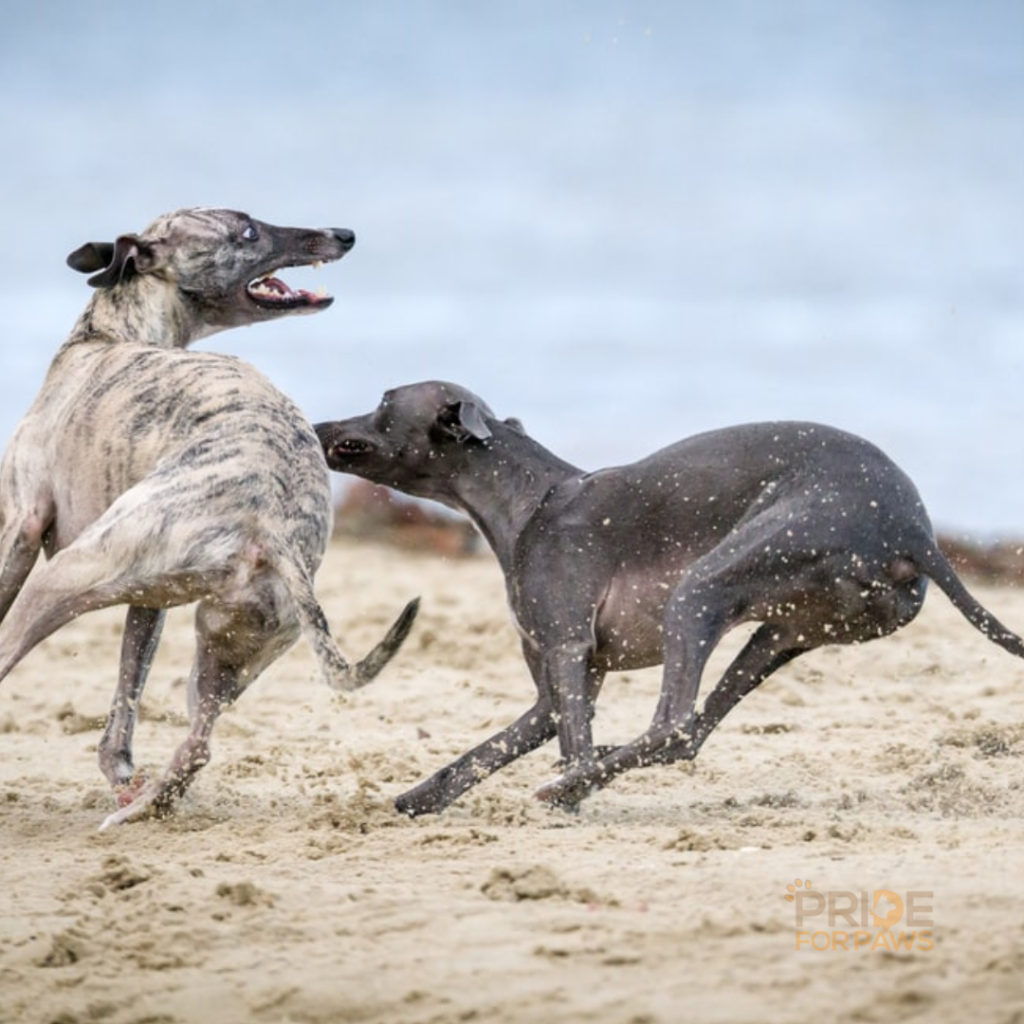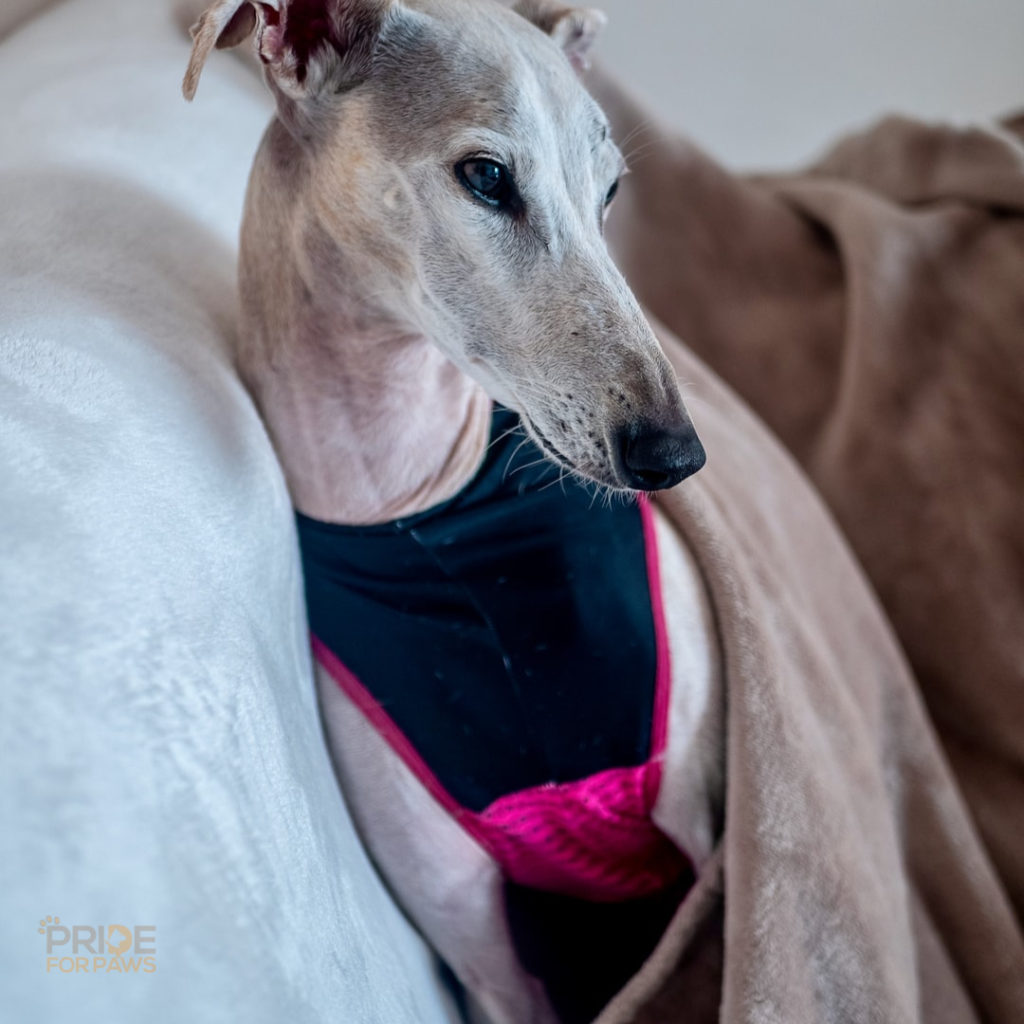Greyhound Dog | The Ultimate Breed Guide

Are you looking for a noble, independent, and gentle dog? Not one other canine can be as strongly connected with speed, grace, and general agility as the greyhound.
Greyhounds have been around the block for a long time. Experts believe that they’ve been around for about 4000 years! These dogs were pets to Egyptian pharaohs and noblemen throughout history.
And, they’re still quite popular.
Greyhounds belong to the Hound Group since they’ve been used for hunting throughout history and have excellent tracking abilities.
In this blog post, we’ll go over everything you need to know about Greyhounds, such as the breed history, characteristics, temperament, health issues, etc.
So, let’s get started, shall we?

Turning Back Time: A Quick Look at the Greyhound History
As we mentioned earlier, Greyhounds have been around for a long, long time. Archeologists have found skeletal remains of these dogs in the middle east that date back to more than 4,000 years.
Records show the Greyhounds were popular devoted dogs to the Egyptian pharaohs and noblemen throughout history.
The American Kennel Club officially recognized the dog breed in 1885.
While modern Greyhounds come in various colors, the breed gets its name because, in the past, these dogs were dominantly gray in color.
Head-Turning Physical Features: Here’s the Deal With Greyhounds!
Greyhounds have unique physical features that set them apart from other dog breeds. These dogs have a long and narrow face, which is wide between the ears. The muzzle is long, and the teeth are sharp and strong.
These dogs have an aerodynamic frame, which is why they are the fastest dog breed in the world!
Greyhounds make excellent working dogs and participate in a lot of sporting activities—mainly racing. These dogs have high activity needs and don’t do well in small, confined spaces.
Height, Weight, and Life Expectancy: Greyhound Edition
Here are a few things you need to note down if you’re looking to get a Greyhound.
Height: 27-30 inches
Weight: 55-88 lbs.
Life Expectancy: 10-14 years.
Greyhounds do have subtle gender differences when it comes to height and weight. Males are generally bigger and heavier than females.
Keep in mind that a dog’s average lifespan depends on various factors like pedigree, medical issues, activity level, food consumed, etc. Some Greyhounds live well over 16 years!

All You Need to Know About a Greyhound’s Personality and Temperament
The best companionship is a compatible one, which is why you should make sure that your lifestyle and personality matches that of your dog’s.
Some dog breeds are low-maintenance and don’t need a lot of attention, while others need constant care and attention. If your dog doesn’t get what he needs, he’ll develop behavioral and personality issues in the long term.
Here’s a quick peek at a Greyhound’s personality and temperament.
Gentle and Quiet
These dogs do well with other dogs and are very gentle and loving. They aren’t verbal like Huskies and don’t like to fuss a lot. They are calm and not too excitable, making them easy to take care of.
Aloof and Indifferent
Greyhounds are aloof and indifferent towards strangers. They act like they don’t see or register them—your Greyhound won’t announce to the world that you have a visitor.
These dogs have a good rep with the neighbors.
Easygoing
What we love about Greyhounds is their easygoing nature and the fact that they’re low-maintenance. You don’t need to groom them often or discipline them. While Greyhounds can be lazy, they do have high activity needs.
A Quick Look at Beed Nutrition, Exercise, and Health

In this section of the article, we’ll go through some important things you need to know about Greyhounds.
Take a look.
A Greyhound’s Nutritional Needs
Greyhounds are active dogs and need an adequate amount of food to remain fit and healthy. You’ll need to make sure your dog is getting the right amount of food!
Keep in mind that a Greyhound’s daily caloric intake depends on various factors like age, weight, health issues, lifestyle, etc. Your vet will be able to guide you the best.
In most cases, an adult Greyhound needs 1000-1200 calories per day.
Exercise and Your Greyhound
Greyhounds have high activity needs. They’ll need 40-60 minutes of daily vigorous physical activity—walks just won’t suffice.
These dogs love going on outdoor adventures with their parents.
So, your pooch will make the perfect companion for hikes, long walks, hunting trips, and more.
A Quick Note on the Breed’s General Health
There’s a reason why Greyhounds have been around for thousands of years—they’re healthy and adaptable dogs!
But, like all deep-chested dog breeds, Greyhounds are prone to developing bloat and GDV. Eye issues such as cataracts are also common in Greyhounds.
Training a Greyhound
Greyhounds aren’t the easiest to train. These dogs have a mind of their own and can be stubborn. You’ll have to start socializing your dog from puppyhood to make sure he gets along with children and other pets.
These dogs get bored easily and need a lot of entertainment. They generally don’t do well when left alone for hours.
Grooming a Greyhound
You don’t need to worry about grooming a Greyhound. These dogs shed minimally and need occasional baths and brushing.
- You should bathe your Greyhound as needed or once every four to six weeks.
- You’ll need to brush your Greyhound’s fur once a week.
- Brush your pooch’s teeth three to four times a week.
- Grind or clip the dog’s nails as needed or once every four to six weeks.
Easy, right?

Final Words
Was this blog post helpful? Share your thoughts in the comments section.
Greyhounds are gentle, intelligent, and king dogs. These dogs are the fastest breed when it comes to running and has been around for thousands of years. Greyhounds are extremely active and need rigorous physical activity every day.
These dogs are adaptable but don’t do well in small spaces.
Do you have any questions? Share them with us in the comments section, and we’ll get back to you.
